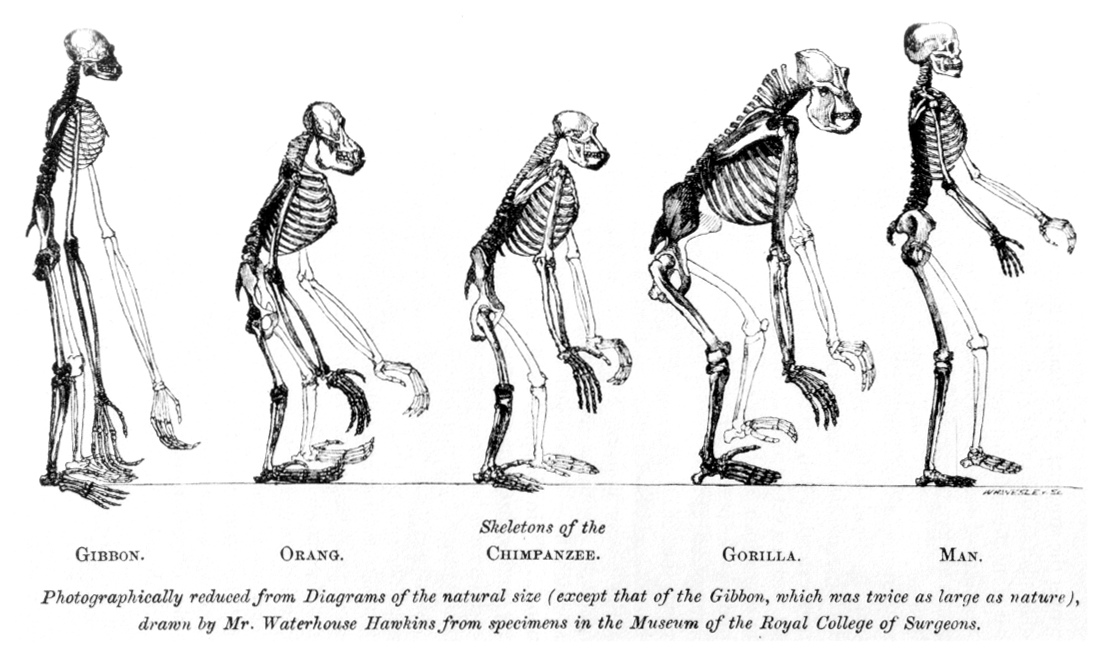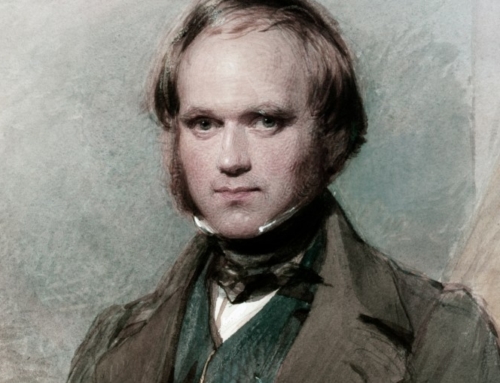Darwin described the lack of transitional fossils as “the most obvious and gravest objection which can be urged against my theory”, but explained it by the extreme imperfection of the geological record.1 And so the hunt was on for intermediate forms which would demonstrate the transition between one species and another. Lyell used the term “missing link” in 1863,2 a common but inaccurate term, although still in popular use today. Here are the main discoveries of the 19th century that were used to support Darwin’s theory.
Transitional Fossils
Less than two years after the publication of The Origin of Species a bird-like fossil was discovered in the Jurassic limestone near Langenaltheim in Bavaria, southern Germany. Named Archaeopteryx, it was feathered with wings but it had teeth, a lizard-like tail and claws at its wingtips. Thomas Huxley saw the fossil as a transitional bird having many reptilian features, linking it to the dinosaur. Other similar discoveries followed and this seemed to confirm Darwin’s theory of evolution and became a key piece of evidence in the transitional fossils debate.
Research involving tomography scanning has suggested that Archaeopteryx had brain and ear functions closely similar to modern birds.3 But recent discoveries in China have led to a re-evaluation of Archaeopteryx and therefore its place as the earliest example of a bird and a transitional fosssil. Resulting from the discovery of a new species, Xiaotingia zhengi, the Archaeopteryx-like fossils have been reclassified and are now placed with the non-avian dinosaurs.4 Some of the features used to link theropod dinosaurs to birds were a three-toed foot, a wishbone, air-filled bones and feathers but an examination of their cardio-vascular anatomy suggests they were unlikely to have had bird-like air-sac lungs.5
- The fossil skeleton of the first Archaeopteryx discovered
Evolution of Man
Two books on ancient man appeared in 1863. Charles Lyell’s volume on the antiquity of man2 considered the discoveries of Palaeolithic (Pleistocene) man but avoided a definitive statement on human evolution. Thomas Huxley’s book,6 however, was about the evolution of man and apes from a common ancestor.
The first discoveries of “Neanderthal man” had been made by the time of Huxley’s book. He regarded the skull as “the most brutal of all human skulls” but still that of a human being.7 His discussion therefore was based solely on contemporary embryological and anatomical evidence, arguing on structural grounds that man might have originated “by the gradual modification of a man-like ape”.
It was later that century that Neanderthal man became a focal point in the debate about human evolution, and this lasted until the mid-twentieth century. During this period he was characterised as a primitive “cave man”.8 But recent research has shown him to be an innovator who made dwellings, used tools and fire, wore clothes, and performed primitive surgery.9
- Huxley’s diagram of apes and man
- Neanderthal – 1888 reconstruction
Since Darwin’s and Huxley’s publications a number of human-like and ape-like fossils have been discovered. Much of the material is fragmentary and views differ on any evolutionary path that might be interpreted from it. New discoveries tend to challenge previous interpretations10 while fossils considered human have been re-identified as ape; recent examples of this include the Longgupo jaw, originally called Wushan Man, from China11 or Ardipithecus ramidus from Ethiopia.12 At a molecular level the DNA sequences of humans and chimpanzees are reported to be 96% similar.13However this disguises the 40 million individual differences at the nucleotide level,14 the different number and structure of chromosomes and the gene gain and loss which, as Demuth et al state, ‘represents a large number of genetic differences separating humans from our closest relatives’.15 Darwinian evolution of man and apes from a common ancestor remains unproven.
- Neanderthal youth – A 2006 reconstruction
Evolution in Embryo Development
The assumption that embryo development replayed an evolutionary ancestry dates to the later eighteenth century. Darwin developed the idea as important evidence of evolution in The Origin of Species and illustrated human and dog embryos in his The Descent of Man16. He noted analogous drawings had already been published by Ernst Haeckel 17 who developed the idea of “ontogeny recapitulates phylogeny” in a subsequent book.18 Haeckel’s illustration of the embryos of different animals became a common illustration in biology text books outside of Germany although it had been exposed as fraudulent there at the time.
Stephen Jay Gould clarifies the issue: ‘Haeckel had exaggerated the similarities by idealizations and omissions. He also, in some cases – in a procedure that can only be called fraudulent – simply copied the same figure over and over again. At certain stages in early development, vertebrate embryos do look more alike …. but these early embryos also differ far more substantially, one from the other, than Haeckel’s figures show.’19
- Haeckel’s embryos
Contemporary Evolution
The other example selected here to show how Darwin’s theory developed in the 19th century is that of the Peppered Moth (Biston betularia). It occurs in two main varieties, a light version named typica and a darker type called carbonaria. The first recorded carbonaria specimen occurred in Manchester in 1848. Subsequent studies found that the incidence of the two types was changing and by the end of the century the dark form predominated. In 1896 an English entomologist, James William Tutt, suggested that this was the result of Darwinian natural selection and proposed the “differential bird predation hypothesis”.20
This hypothesis assumed that this change was the outcome of industrial pollution. The trees used by peppered moths to rest during the daytime had lost their lichens and had darkened. As a result the previously camouflaged typica moths were now highly conspicuous on the blackened trees and easily spotted by predatory birds. The darker carbonaria moths therefore blended with their resting place and so survived longer leaving more offspring than the light forms. Despite some controversy, recent research has confirmed bird predation and in a modern, less polluted environment, that there is now an increase in the number of the light-coloured typica moths.21
- Peppered Moth varieties
The Peppered Moth provides an excellent example of the impact of a changing environment and bird predation as agents of natural selection. Other examples interpreted as natural selection occur in both the contemporary world as well as the fossil record, some of the latter leading to extinction. But it is not possible from this evidence to extrapolate a Darwinian theory of evolution involving changing body plans or a common ancestor to all life.









